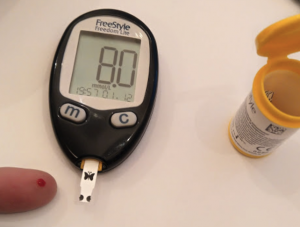Jack’s Health Part B: Diabetic Foot Ulcer
Jack is found by his daughter unkempt, shortness of breath, limping slightly, and has a strange odor coming from him. Jack states he has not been eating or managing his blood sugars & insulin well.
He has not bathed since his wife went to hospital because he is unable to access the bathtub safely. His daughter Nancy, finds an open, oozing wound on Jack’s foot.

Wagner Ulcer Classification System
The most widely accepted classification system for diabetic foot ulcers and lesions is the Wagner ulcer classification system, which is based on the depth of penetration, the presence of osteomyelitis or gangrene, and the extent of tissue necrosis
- 0: no open lesions, may have healed lesion
- 1: superficial ulcer without penetration to deeper layers
- 2: deeper ulcer, reaching tendon, bone, or joint capsule
- 3: deeper tissues involved, with abscess, osteomyelitis, or tendonitis
- 4: gangrene in a portion of forefoot or heel
- 5: extensive gangrenous involvement of the entire foot
Causes of Diabetic Foot Ulcers
- Poor circulation – blood does not flow to feet efficiently, also making ulcers more difficult to heal
- Hyperglycemia – can slow healing process
- Nerve damage – tingling and pain, decrease or loss of feeling
- Irritated or wounded foot – reduced sensitivity results in painless wounds
- Wearing inappropriate footwear – may be significant in wound progression

Jack gets a wound swab at the hospital
The different types of wound swabs are:
Transport Media
- Amies
- Swabs should be stored at room temp., ideally within 30 minutes
- Reject swabs that are significantly delayed
- Reject swabs if they are not in a transport medium (i.e. Amies or anaerobic medium)
Media & Incubation requirements
- BAP (CO2)
- AN BAP 🡪 to check for anaerobes
- CNA O2 🡪 deep wound, below the waist, used to rule out fecal/flora contamination
- MAC O2 🡪 isolate gram-negative bacteria
where,
- BAP → blood agar plate
- AN BAP → anaerobic blood agar plate
- CNA → Colistin Nalidixic Acid plate
- MAC → MacConkey plate

Clinical Gram
- Good indicator of specimen quality
- Good quality wound swabs have:
- pus cells present
- few epithelial cells

Treating Jack’s foot ulcer
Treatment primarily depends on the stage of the ulcer. Essential to start treatment as soon as possible – helps prevent infection and provides better results sooner
Jack requires the following treatments:
- Antibiotics if applicable (C&S of wound site)
- Shoes designed for individuals with DM
- Debridement
- Foot baths
- Disinfecting the skin around the ulcer
Ulcer care
- Keeping the ulcer dry with frequent dressing changes
- Dressings containing calcium alginates to inhibit bacterial growth
- Surgical procedures – shave bone or removing foot abnormalities (bunions or hammertoes)
- Other treatment options ineffective – amputation
Preventing Diabetic Foot Ulcers
- Washing feet every day
- Keeping toenails adequately trimmed, but not too short
- Keeping your feet dry & moisturized
- Changing socks frequently
- Seeing a podiatrist for corn & callus removal
- Wearing proper-fitting shoes

